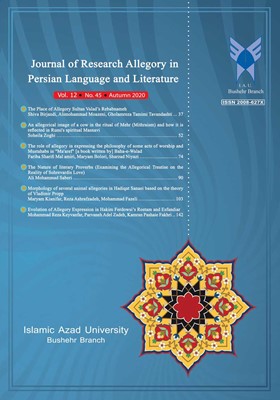The role of allegory in expressing the philosophy of some acts of worship and Mustahabs in "Ma'aref" [a book written by] Baha-e-Walad
Subject Areas : Research Allegory in Persian Language and LiteratureFariba Sharifi Mal amiri 1 , maryam bolouri 2 * , Sharzad Niyazi 3
1 - Ph.D Student of Persian language and literature, Islamic Azad University, Najaf Abad, Esfahan, Iran
2 - Assistant professor of Persian Language and Literature, Najaf Abad branch, Islamic Azad University, Najaf Abad, Iran
3 - Assistant professor of Persian Language and Literature, Najaf Abad branch, Islamic Azad University, Najaf Abad, Iran
Keywords:
Abstract :
Allegory is one of the measures of rhetoric in conveying rational concepts. Baha-e-Walad in Ma'aref was able to turn simple prose into poetic prose by using this illustrative element. In this research, in an analytic-library method, we investigate the role allegory in clarifying the philosophy of some acts of worship, such as prayer, fasting …and also, dhikrs and mustahabs in Ma'aref book, and we have also followed the same themes in books such as Kashfah al-Mahjoub, Fih-e-Mafih, Kimiay-e-Sa'adat, and Mersad al-Ebad.The results show that "Ma'aref" considered prayer as the most important religious duty that consists of three parts: call to prayer, ablution and dhikrs of prayer and allegory is used most frequently about prayer and its etiquette in which 7 cases are about prayer and its dhikrs, 4 cases are about ablution and 1 case is about call of prayer. After the prayer, the Prevention of Vice is in the second place with 7 allegories. Hajj and fasting are equally in the third place with 3 allegories. The virtue of the month of Rajab also has a significant place for Baha-e-Walad who had used 7 allegories in introducing its value. It should be noted that the allegories in Ma'aref are all based on new sensory similes and are less clichéd. That is why allegories used by Baha-e-Walad , help his addressees to more enjoy understanding the religious Duties and Obligations without trying to force and making the addressee to understand. Allegory has little place in other mentioned books.
قرآن کریم. (۱۳۸۳). ترجمة الهی قمشهای، تهران: چاپخانه اعتماد.
_||_

